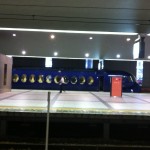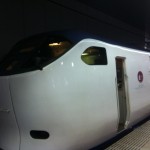The Japanese take their trains very seriously. We saw some quite striking train cars pull up to Kansai International Airport. It seemed like a car show but with trains.
On some trains, the conductors wear white gloves. On ours, the conductor turned and bowed every time he left a train car and went through to the next one. On regular subway trains, the seats are upholstered and just as comfortable as living room sofas. For the most part, riders are absolutely silent. Occasionally, we forgot about this custom and spoke to each other quietly. When we did, people next to us who were reading gave us stinkeyes to remind us. Usually, it’s quite relaxing though. The only major exception is during the evening rush hour after all the businessmen have been out to drink with their colleagues. The train rides are noticeably smoother than those I’m used to in Boston.
- This train billboard was just a photo of pansies with no message. Also pictured: Matthew “Sunset” Eng.
- Sunset on our train ride from Kansai International Airport to our hotel. No relation to Matthew “Sunset” Eng.
On most trains I’m used to, we have half of the seats in the main cabin face one direction and the other half face the opposite direction. In this Japanese train, they have seats that all face the same direction and then they rotate (by remote control) 180 degrees when the train changes direction.
Subway fares here are a bit more expensive than in the U.S. (though it’s hardly noticeable if you go a short distance). This is magnified with longer trips though. To get from Osaka to Tokyo, it costs between $250 and $300 at the time of writing, which is about twice the price to get from Boston to New York City. However, in Japan, you would get to ride the Shinkansen, which would help make up for it. We probably won’t be doing this since we’re a bit grounded here in Osaka.
Also as a fun bonus, Japan holds the world record for non-conventional passenger trains with the SC Maglev. It’s an impressive feat of engineering, and I would love to see it. However, I wonder about the energy consumption involved in moving these things at 500-some-odd km/h. On the one hand, there’s very little friction, but on the other hand, the trains are being lifted off the ground and propelled by electricity. Also, in terms of side benefits, one can squash a coin by leaving it on the rail of a train with wheels. With maglev, the coin would just get very stuck to either the rail or the underside of the train, but maybe some people would get a kick out of that.
There is a train museum featuring the SC Maglev and other trains. It sounds amazing, but it’s in Nagoya, which is time-consuming and expensive to get to. This is a dilemma I’ll ponder for a bit.



